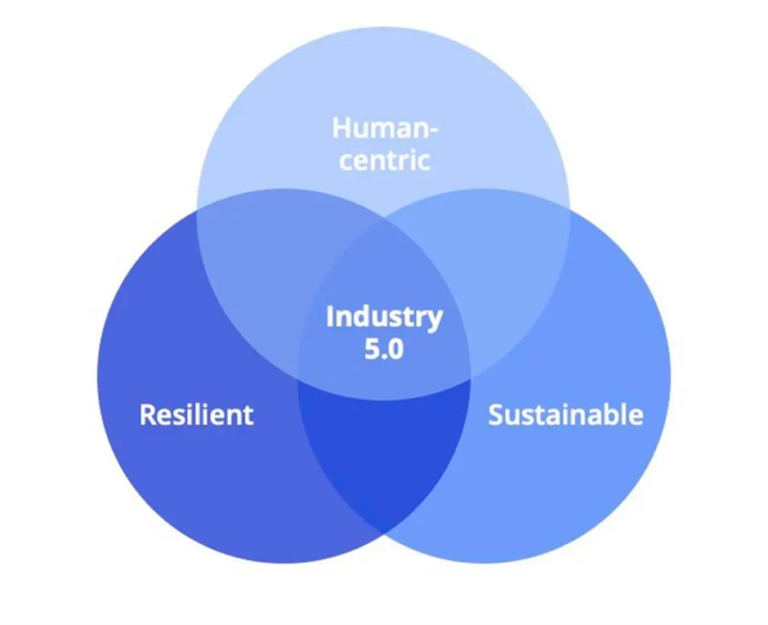What Is Industry 5.0 And How It Will Radically Change Your Business Strategy?
What Is Industry 5.0 And How It Will Radically Change Your Business Strategy?
Jeroen Kraaijenbrink, Forbes
What is Industry 5.0?
Industry 5.0 is a recent concept that emphasizes goals beyond efficiency and productivity, highlighting the industry’s societal role. It prioritizes worker well-being and uses technology for prosperity while respecting environmental limits. This complements Industry 4.0 by emphasizing research and innovation for a sustainable, human-centered European industry.
Essentially, Industry 5.0 represents a fundamental shift from emphasizing economic to societal value, and from focusing on welfare to overall well-being. While not a novel concept, the emphasis on societal well-being has been part of capitalist discourse for a considerable time, seen in concepts like Corporate Social Responsibility, ESG, and the Triple Bottom Line. What sets Industry 5.0 apart is the prioritization of people and the environment over profits and expansion at the very core of what defines industry. This constitutes a radical departure in redefining the primary objectives of industry.
The emphasis on societal value and well-being aligns with a growing trend in recent years. This trend is reflected in the thought-provoking perspectives on business and economics presented in influential books like Kate Raworth’s “Doughnut Economics” (2017), John Elkington’s “Green Swans” (2020), and Paul Polman and Andrew Winston’s “Net Positive” (2021).
What Does Industry 5.0 Mean for Your Strategy?
Industry 5.0 extends beyond conventional industry, applying to all sectors and organizations. Its scope surpasses that of Industry 4.0. The strategic implications of Industry 5.0 are broad, impacting all industries. The European Commission identifies three key pillars: human-centric, resilient, and sustainable, each carrying significant implications for business strategy.

Human-Centric Strategy
A human-centric approach, highlighted in the infographic, prioritizes talents, diversity, and empowerment. This shift marks a move from viewing people as resources to valuing them as ultimate objectives. It signifies a transition from organizations being served by people to organizations actively serving people.
This shift aligns with current labor market dynamics, where attracting and retaining talent has become a more formidable task than acquiring and retaining customers in many industries and regions. Industry 5.0 addresses this by putting a strong emphasis on human-centric strategies.
Traditionally, business strategy has revolved around gaining a competitive advantage to offer unique value to customers. However, in a human-centric paradigm, the primary strategic objective shifts towards gaining a competitive edge to provide distinct value to employees, which deviates from the conventional approach advocated by influential strategist Michael Porter.
Resilient Strategy
The European Commission advocates for a resilient strategy characterized by agility, adaptability, and flexible technologies, especially in light of recent global challenges. However, this shift represents a deeper transformation than it might initially appear. While agility and flexibility have been prioritized in corporate agendas, they don’t necessarily lead to greater resilience. Current business practices are often geared towards efficiency and profit maximization, which can hinder rather than enhance resilience. Embracing resilience as a core pillar of Industry 5.0 implies a shift away from the traditional focus on growth and efficiency, towards building “anti-fragile” organizations that can effectively anticipate, respond, and learn from crises, ensuring stable and sustainable performance.
Sustainable Strategy
In light of widespread concerns about climate change, sustainability is a well-recognized concept. As defined by the European Commission, a sustainable strategy involves taking decisive action on sustainability while respecting the planet’s limits. This encompasses considering all aspects of the Triple Bottom Line and all 17 Sustainable Development Goals.
This marks a significant departure from past practices. Until now, corporate sustainability efforts have primarily focused on minimizing damage or, in some cases, engaging in greenwashing. This essentially means conducting business as usual, but with a heightened sense of responsibility.
However, fully integrating sustainability into a company’s strategy goes beyond current practices. Truly sustainable companies aim not only to reduce negative impact but also to increase their positive contributions. This approach, outlined in Polman and Winston’s book “Net Positive” and echoed by Elkington’s concept of “Green Swans,” involves actively creating positive disruptions to improve the world. In Industry 5.0, companies are transitioning from being part of the problem to becoming part of the solution.
What’s Next?
Currently, the Industry 5.0 concept has not gained widespread adoption, as many businesses remain focused on Industry 4.0 or earlier stages. The sustainability movement is also in its early stages. However, the European Union’s push towards Industry 5.0, based on its three core pillars, offers a clear vision for future progress.
Reactions to this vision will vary, with some finding it inspiring while others may see it as daunting. The level of adoption will differ greatly among companies and individuals. Nevertheless, in light of the significant challenges and crises we face, Industry 5.0 appears to be a plausible and beneficial response. As organizations and societies become more human-centric, resilient, and sustainable, we can anticipate the emergence of innovative solutions.
Source:
https://www.forbes.com/sites/jeroenkraaijenbrink/2022/05/24/what-is-industry-50-and-how-it-will-radically-change-your-business-strategy/?sh=c633e9c20bd6

Comments :